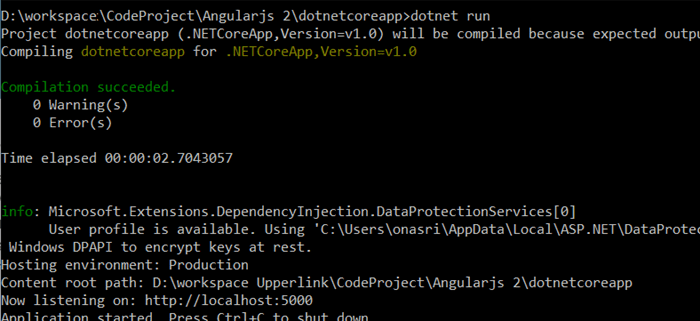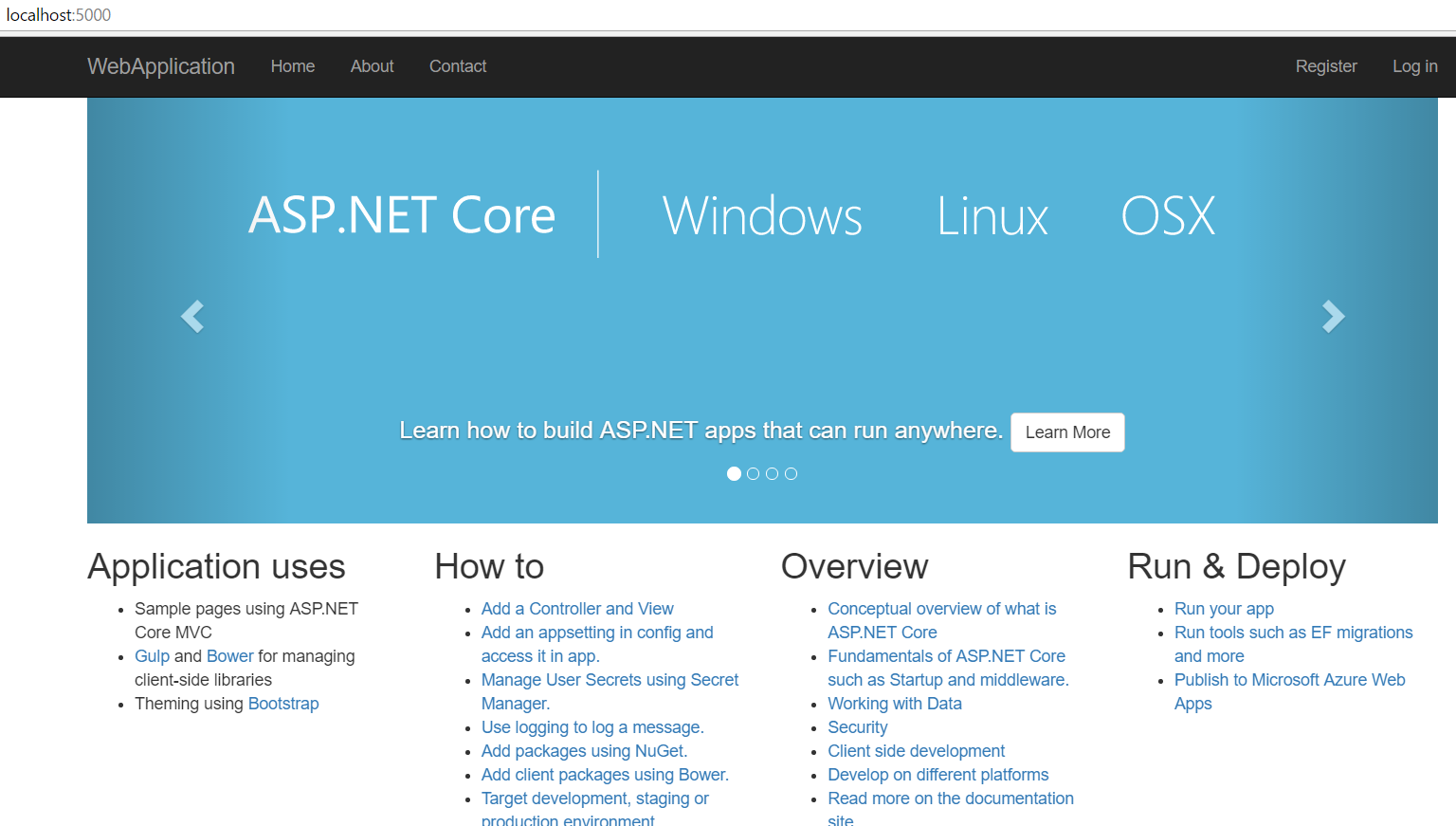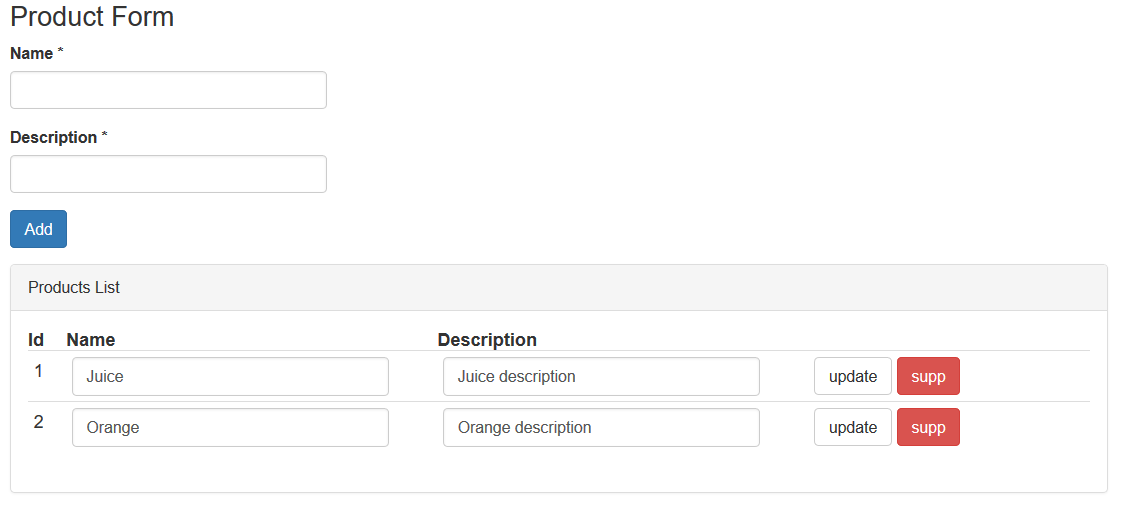[译]带有Angular 2和Web API的ASP.NETCore MVC中的CRUD
By robot-v1.0
本文链接 https://www.kyfws.com/applications/crud-in-asp-netcore-mvc-with-angular-and-web-api-zh/
版权声明 本博客所有文章除特别声明外,均采用 BY-NC-SA 许可协议。转载请注明出处!
- 12 分钟阅读 - 5646 个词 阅读量 0[译]带有Angular 2和Web API的ASP.NETCore MVC中的CRUD
原文地址:https://www.codeproject.com/Articles/1151474/CRUD-in-ASP-NETCore-MVC-with-Angular-and-Web-API
原文作者:O.Nasri
译文由本站 robot-v1.0 翻译
前言
A good example of how build a CRUD web application using ASP.NETCORE with Angular2 and WebApi
一个很好的示例,说明如何使用ASP.NETCORE和Angular2和WebApi构建CRUD Web应用程序
- 下载源代码(ZIP)-16.7 MB(Download source code (ZIP) - 16.7 MB)
- 下载源代码(RAR)-14.7 MB(Download source code (RAR) - 14.7 MB)
介绍(Introduction)
通过本文,您将学习如何创建CRUD Web应用程序.(Through this article, you will learn how you can create a CRUD web application.)
CRUD应用程序是指可以在数据源(例如数据库,XML文件等)上创建,读取,更新和删除记录的应用程序.(CRUD application means an application that can Create, Read, Update and Delete records on a Data Source (such as a Database, XML File, etc.).)
在本演示的结尾,您将学习如何:(At the end of this demo, you will learn how to:)
-
创建一个ASP.NETCore MVC应用程序(Create an ASP.NETCore MVC application)
-
使用npm安装所需的软件包(Angular2,打字等)(Install required packages (Angular2, Typings, etc.) using npm)
-
对安装在数据库中的现有数据库进行逆向工程(Reverse engineering of an existing database installed on)SQL服务器(SQL Server)(使用实体框架优先方法)((using Entity Framework First Approach))
-
创建一个(Create a)RestFul(RestFul)服务器使用(Server using)WebApi(WebApi)
-
在Angular 2上创建组件,模板,服务和类(Create components, template, services, and classes on Angular 2)
-
编译(Compile)角度2(Angular2)项目使用(project using)网页包(webpack)
-
运行ASP.NETCORE MVC Web应用程序(Run the ASP.NETCORE MVC web application) 在本文中,我依靠以下链接来构建我的应用程序:(In this article, I relied on the following links to build my application:)
背景(Background)
为了更好地理解此演示,最好具有以下方面的知识:(To better understand this demo, it is preferable that you have a good knowledge’s of:)
- 使用C#,JavaScript和HTML进行编程(Programming in C#, JavaScript and HTML)
- MVC架构(MVC architecture)
- SQL语言(SQL language)
- 数据绑定(Data Binding)
- 实体框架(Entity Framework)
- Visual Studio程式码(Visual Studio Code)
先决条件(Prerequisites)
要运行此示例,您需要安装:(To run this example, you need to install:)
使用代码(Using the Code)
构建Web应用程序(Building the Web Application)
在本节中,我将逐步向您解释如何轻松构建CRUD Web应用程序:(In this section, I will proceed step by step to explain to you how you can easily build a CRUD web application:)
A)设置ASP.NETCore MVC项目(A) Setup ASP.NETCore MVC Project)
打开CMD控制台(我建议您在管理员模式下执行它)并编写以下命令:(Open your CMD console (I recommend you to execute it in Administrator mode) and write the following commands:)
mkdir dotnetcoreappcd dotnetcoreappdotnet new -t web创建Web应用程序(to create web application)dotnet restore加载依赖项(to load dependencies)dotnet run开始申请(to start application) 结果:(Result:)
使用浏览器导航到给定的URL(http://localhost:5000),您应该看到:(Use your browser to navigate to the given url (http://localhost:5000), you should see:)
B)创建和配置Angular2项目(B) Create and Configure Angular2 Project)
根据Angular2官方文档,您将创建相同的配置文件:(Based on the official Angular2 documentation, you will create the same configuration files:)
-
package.json(package.json)
-
tsconfig.json(tsconfig.json)
-
Types.json(typings.json) 接下来,您应该安装(Next, you should install)
typescript,(,)typings和(and)webpack使用(using)npm:(:) -
Npm install –g typescript -
Npm install -g typings -
Npm install -g webpack最后,您将在(Finally, you will introduce some change in the)**启动文件(Startup.cs)**文件支持(file to support)Angular2单页应用程序(Angular2 Single Page Application),则应将默认的ASP.NETCore MVC路由更改为指向(, you should change the default ASP.NETCore MVC routing to point on the)指数(index)的页面(page of the)角度2(Angular2)项目((project ()wwwroot/index.html(wwwroot/index.html)).所以你会改变(). So you will change the)Configure专门针对路由代码的方法:(method a little bit specially on routing code:)
public void Configure(IApplicationBuilder app, IHostingEnvironment env, ILoggerFactory loggerFactory)
{
loggerFactory.AddConsole(Configuration.GetSection("Logging"));
loggerFactory.AddDebug();
if (env.IsDevelopment())
{
//read error details
app.UseDeveloperExceptionPage();
app.UseDatabaseErrorPage();
app.UseBrowserLink();
}
else
{
app.UseExceptionHandler("/Home/Error");
}
//point on the index page of the Angular2 project
app.Use(async (context, next) =>
{
await next();
if (context.Response.StatusCode == 404
&& !Path.HasExtension(context.Request.Path.Value))
{
context.Request.Path = "/index.html";
await next();
}
});
app.UseStaticFiles();
app.UseMvc();
}
C)设置数据库(C) Setup DataBase)
1)创建数据库(1) Create Database)
我使用SQL Server 2014在本地托管数据库.(I used SQL Server 2014 to locally host my database.)
以下步骤将帮助您准备数据库:(The following steps will help you to prepare your database:)
- 添加一个名为的新数据库(Add a new database named)
DataBaseDotnetCore到您的服务器(to your server) - 执行以下SQL脚本以创建一个名称为非空的表(Execute the following SQL Script to create a not empty table named)
Product
2)使用实体框架优先方法(2) Using Entity Framework First Approach)
在本节中,您将进行逆向工程以从现有数据库创建实体框架模型.为此,您应该按照以下步骤操作:(In this section, you will do a reverse engineering to create an Entity Framework model from your existing database. To do that, you should follow the steps given below:)
-
导航到应用程序的根文件夹((Navigate to the root folder of application ()**dotnetcoreapp(dotnetcoreapp)**夹)(folder))
-
导入所需的依赖项和工具:为此,您应该配置(Import required dependencies and tools: to do that, you should configure the)**project.json(project.json)**通过:(by:)
- 添加以下依赖项:(Adding the following dependencies:)
- 添加工具:(Adding tools:)
- 保存更改并执行命令行:(Saving the changes and executing the command line:)
-
编写以下命令行以开始逆向工程:(Write the following command-line to start the process of reverse engineering:)例如:(For example:)
-
最后,修改(Finally, modify the)
ConfigureServices方法开启(method on)**启动文件(Startup.cs)**文件以创建到数据库的连接:(file to create a connection to your database:)
D)设置Restful WebApi(D) Setup Restful WebApi)
在此步骤中,您将创建一个名为(In this step, you will create a controller named)**ProductsController.cs(ProductsController.cs)**实现了一些(that implements some)HTTP动词(HTTP verbs):(:)
Get:检索列表(: to retrieve the list of)product来自数据库(from database)Post:添加一个新的(: to add a new)ProductPut:更新特定(: to update a specific)ProductDelete:删除特定的(: to remove a specific)Product
using System;
using System.Collections.Generic;
using Microsoft.AspNetCore.Mvc;
using angularapp.Models;
using System.Linq;
using Microsoft.EntityFrameworkCore;
namespace WebApplication
{
[Route("api/[controller]")]
[ResponseCache(Location = ResponseCacheLocation.None, NoStore = true, Duration = -1)]
public class ProductsController : Controller
{
private DataBaseDotnetCoreContext _context;
public ProductsController(DataBaseDotnetCoreContext context)
{
_context = context;
}
[HttpGet]
public IEnumerable<dynamic> Get()
{
return _context.Product.ToList();
}
[HttpPost]
public string Post([FromBody] Product product)
{
Response.StatusCode = 200;
try{
angularapp.Models.Product newProduct = new Product();
newProduct.Name = product.Name;
newProduct.Description= product.Description;
_context.Product.Add(newProduct);
_context.SaveChanges();
}catch(Exception e){
Response.StatusCode = 400;
return e.ToString();
}
return "OK";
}
[HttpPut]
public string Put([FromBody] Product product)
{
Response.StatusCode = 200;
try{
product.Name = product.Name;
product.Description= product.Description;
_context.Product.Attach(product);
_context.Entry(product).State = EntityState.Modified;
_context.SaveChanges();
}catch(Exception e){
Response.StatusCode = 400;
return e.ToString();
}
return "OK";
}
[HttpDelete]
public String Delete(int id)
{
Response.StatusCode = 200;
try{
angularapp.Models.Product newProduct = new Product();
newProduct.Id = id;
_context.Product.Remove(newProduct);
_context.SaveChanges();
}catch(Exception e){
return e.ToString();
}
return "OK";
}
}
}
E)设置Angular2项目(前端部分)(E) Setup Angular2 Project (frontend part))
在里面(In the)**wwwroot/app(wwwroot/app)**文件夹,创建以下文件:(folder, create the following files:)
a)product.service.ts(a) product.service.ts)
这是我们的服务类,可实现所需的方法和接口,例如:(This is our service class that implements needed methods and interfaces such as:)
AnnounceChange方法:向观察者发送通知,以将刷新数据调用到视图列表中,(method: sends a notification to observers to call refresh data into a list of view,)LoadData方法:由于调用了现有的Web服务[(method: loads data from database, thanks to the call of an existing web service [)/api/产品(/api/products)],(],)Add方法:调用外部Web服务[(method: invokes an external web service [)/api/产品(/api/products)]添加一个新的(] that add a new)Product对象进入数据库,(object into database,)Update方法:通过调用现有的Web服务将现有产品的某些内容更新到数据库中[(method: updates some content of an existing product into database by calling an existing web service [)/api/产品(/api/products)],(],)Delete方法:通过调用现有的Web服务从数据库中删除特定产品[(method: deletes a specific product from database by calling an existing web service [)/api/产品(/api/products)],(],)IProduct类:构成(class: constitutes an)interface对于(for)Product类.(class.)
import { Injectable } from '@angular/core';
import { Http, Response, RequestOptions, Headers } from '@angular/http';
import { Observable, Subject } from 'rxjs/Rx';
import 'rxjs/add/operator/toPromise';
@Injectable()
export class ProductService {
constructor(private _http: Http) { }
private RegenerateData = new Subject<number>();
// Observable string streams
RegenerateData$ = this.RegenerateData.asObservable();
AnnounceChange(mission: number) {
this.RegenerateData.next(mission);
}
LoadData(): Promise<iproduct[]> {
return this._http.get('/api/products')
.toPromise()
.then(response => this.extractArray(response))
.catch(this.handleErrorPromise);
}
Add(model) {
let headers = new Headers({ 'Content-Type':
'application/json; charset=utf-8' });
let options = new RequestOptions({ headers: headers });
delete model["id"];
let body = JSON.stringify(model);
return this._http.post('/api/products/', body,
options).toPromise().catch(this.handleErrorPromise);
}
Update(model) {
let headers = new Headers({ 'Content-Type':
'application/json; charset=utf-8' });
let options = new RequestOptions({ headers: headers });
let body = JSON.stringify(model);
return this._http.put('/api/products/', body,
options).toPromise().catch(this.handleErrorPromise);
}
Delete(id: number) {
return this._http.delete('/api/products/?id=' +
id).toPromise().catch(this.handleErrorPromise);
}
protected extractArray(res: Response, showprogress: boolean = true) {
let data = res.json();
return data || [];
}
protected handleErrorPromise(error: any): Promise<void> {
try {
error = JSON.parse(error._body);
} catch (e) {
}
let errMsg = error.errorMessage
? error.errorMessage
: error.message
? error.message
: error._body
? error._body
: error.status
? `${error.status} - ${error.statusText}`
: 'unknown server error';
console.error(errMsg);
return Promise.reject(errMsg);
}
}
export interface IProduct {
id : number ,
name : string ,
description : string
}
b)app.componentHW.ts(b) app.componentHW.ts)
这是组件的核心.它包含应用程序的模板和实现:(This is the core of the component. It contains the template and implementation of the application:)
refresh方法:通过调用"通过从外部服务接收数据来刷新产品视图的现有列表(method: Refreshes the existing list of product view by receiving data from an external service by calling “)loadData的方法 “(method” of “)_service变量”,(variable” ,)onUpdate方法:通过调用"的更新方法"来更新数据库上的现有产品(method: Updates an existing product on the database by calling “Update method” of “)_service变量”,(variable",)onDelete方法:通过调用"删除由其"唯一密钥"标识的现有产品(method: Deletes an existing product identified by its “unique key” by calling “)Delete的方法 “(method” of “)_service变量”.(variable” .)
import { Component, OnInit } from '@angular/core';
import { ProductService, IProduct } from './product.service';
import { ProductForm } from './productForm';
import { Subscription } from 'rxjs/Subscription';
@Component({
selector: 'myhw',
template: `
<div class='row'>
<pform></pform>
</div>
<div class='row'>
<div class="panel panel-default">
<!-- Default panel contents -->
<div class='panel-heading'>Products List</div>
<div class='panel-body'>
<table class='table table-condensed'>
<thead>
<th>Id</th>
<th>Name</th>
<th>Description</th>
<th></th>
</thead>
<tbody>
<tr *ngFor="let person of persons" >
<td> {{person.id}} </td>
<td> <input type="text"
[(ngModel)]="person.name"
name="pname"
class="form-control" /> </td>
<td> <input type="text"
[(ngModel)]="person.description"
name="pdescription"
class="form-control" /> </td>
<td> <input type="button"
value="update" class="btn btn-default"
(click)="onUpdate(person)"/>
<input type="button" value="remove"
class="btn btn-danger"
(click)="onDelete(person.id)"/></td>
</tr>
<tbody>
</table>
</div>
</div>
</div>
`
})
export class HwComponent extends OnInit {
subscription: Subscription;
refresh(){
this._service.loadData().then(data => {
this.persons = data;
})
}
constructor(private _service: ProductService) {
super();
this.subscription = _service.RegenerateData$.subscribe(
mission => {
console.log("Good !! ", mission);
this.refresh();
});
}
ngOnInit() {
this.Refresh();
}
onUpdate(elem){
console.log(elem);
this._service.Update(elem).then(data => {
})
}
onDelete(elem : number){
console.log("Delete Form ! ");
console.log(elem);
this._service.Delete(elem).then(data => {
this.Refresh();
})
}
persons: IProduct[] = [];
ngOnDestroy() {
// prevent memory leak when component destroyed
this.subscription.unsubscribe();
}
}
c)产品(c) Product.ts)
此类包含有关的详细信息(This class contains details for) product 项目.(item.)
export class Product {
constructor(
public id : number,
public name : string,
public description : string
){
}
}
d)productForm.component.html(d) productForm.component.html)
这是(This is the)的HTML(HTML)用于我们的模板(template used for our) Product 形成.(Form.)
<div>
<h3>Product Form</h3>
<form>
<div class="form-group">
<label for="name">Name *</label>
<input type="text" class="form-control"
[(ngModel)]="model.name" name="name" required>
</div>
<div class="form-group">
<label for="description">Description *</label>
<input type="text" class="form-control"
[(ngModel)]="model.description" name="email">
</div>
<button type="button" (click)="onSubmit()"
class="btn btn-primary">Add</button>
</form>
</div>
e)productForm.ts(e) productForm.ts)
构成我们后面的代码(Constitute the code behind for our) productForm 模板,您将在其中实现:(template, in which you will have the implementation of:)
onSumbit事件:此事件用于调用添加服务方法(event: This event is used to invoke the Add service method)model属性:与表单的字段绑定(attribute: That binds with the field of the Form)
import { Component, OnInit } from '@angular/core';
import { Product } from './Product';
import { ProductService, IProduct } from './product.service';
@Component({
moduleId: __filename,
selector: 'pform',
templateUrl: './app/productForm.component.html'
})
export class ProductForm {
constructor(private _service: ProductService) {
}
model = new Product(0,'','');
submitted = false;
onSubmit() {
console.log("Sumbitted Form ! ");
this.submitted = true;
this._service.Add(this.model).then(data => {
this._service.AnnounceChange(1212);
})
}
// TODO: Remove this when we're done
get diagnostic() { return JSON.stringify(this.model); }
}
f)app.module.ts(f) app.module.ts)
该文件将用于:(This file will be used to:)
- 通过单词key导入所需的Angular2模块:(import needed Angular2 modules via the word key: “)
imports“(") - 通过单词关键字声明组件:"(declare components via the word key: “)
declarations“(") - 通过单词key声明服务:"(declare services via the word key: “)
providers“(") - 指定要包含的根组件(specify the root components to include into)index.html(index.html) `` 通过单词关键字文件:(file via the word key : “)
bootstrap“(")
import { NgModule } from '@angular/core';
import { HttpModule } from '@angular/http';
import { FormsModule } from '@angular/forms';
import { BrowserModule } from '@angular/platform-browser';
import { HwComponent } from './app.componentHW';
import { ProductService } from './product.service';
import {ProductForm } from './productForm';
@NgModule({
imports: [ BrowserModule,
FormsModule,
HttpModule],
declarations: [ HwComponent, ProductForm],
providers: [
ProductService
],
bootstrap: [ HwComponent]
})
export class AppModule { }
导航(Navigate to)**wwwroot(wwwroot)**您将在其中开始创建前端项目的文件夹:(folder in which you will start the creation of the frontend project:)
a)systemjs.config.js(a) systemjs.config.js)
该文件用于加载使用(This file is used to load modules compiled using the) TypeScript 编译器.(compiler.)
/**
* System configuration for Angular 2 samples
* Adjust as necessary for your application needs.
*/
(function (global) {
System.config({
paths: {
// paths serve as alias
'npm:': '../node_modules/'
},
// map tells the System loader where to look for things
map: {
// our app is within the app folder
app: 'app',
// angular bundles
'@angular/core': 'npm:@angular/core/bundles/core.umd.js',
'@angular/common': 'npm:@angular/common/bundles/common.umd.js',
'@angular/compiler': 'npm:@angular/compiler/bundles/compiler.umd.js',
'@angular/platform-browser':
'npm:@angular/platform-browser/bundles/platform-browser.umd.js',
'@angular/platform-browser-dynamic':
'npm:@angular/platform-browser-dynamic/bundles/platform-browser-dynamic.umd.js',
'@angular/http': 'npm:@angular/http/bundles/http.umd.js',
'@angular/router': 'npm:@angular/router/bundles/router.umd.js',
'@angular/forms': 'npm:@angular/forms/bundles/forms.umd.js',
// other libraries
'rxjs': 'npm:rxjs',
},
meta: {
'./app/main.js': {
format: 'global'
}
},
// packages tells the System loader how to load when no filename and/or no extension
packages: {
app: {
main: './main.js',
defaultExtension: 'js'
},
rxjs: {
defaultExtension: 'js'
}
}
});
})(this);
b)index.html(b) index.html)
这个HTML文件是应用程序的入口,我们将包括所有必需的JS,CSS文件以呈现我们的组件.(This HTML file is the entry point of the application, in which we will include all required JS, CSS files to render our components.)
<html>
<head>
<title>Angular 2 QuickStart</title>
<meta charset="UTF-8">
<meta name="viewport" content="width=device-width, initial-scale=1">
<link rel="stylesheet" href="css/site.css">
<link rel="stylesheet" href="css/bootstrap.min.css">
<!-- 1. Load libraries -->
<script src="js/core.js"></script>
<script src="js/zone.js"></script>
<script src="js/reflect.js"></script>
<script src="js/system.js"></script>
<!-- 2. Configure SystemJS -->
<script src="systemjs.config.js"></script>
<script>
System.import('app').catch(function(err){ console.error(err); });
</script>
</head>
<!-- 3. Display the application -->
<body>
<div class="container">
<myhw>Loading ...</myhw>
<div>
</body>
</html>
最后,您应该配置(Finally, you should configure) webpack 至:(to:)
- 需要出口(Export required)
node_modules至(to)**wwwroot/js(wwwroot/js)**夹(folder) - 转运(Transpile)
**main.ts**到名为(to JavaScript file named)main.js(main.js) 要做到这一点,(To do that,)导航到根文件夹(navigate to the root folder)((()dotnetcoreapp/(dotnetcoreapp/)),然后创建(), and create)webpack.config.js(webpack.config.js):(:)
module.exports = [
{
entry: {
core: './node_modules/core-js/client/shim.min.js',
zone: './node_modules/zone.js/dist/zone.js',
reflect: './node_modules/reflect-metadata/Reflect.js',
system: './node_modules/systemjs/dist/system.src.js'
},
output: {
filename: './wwwroot/js/[name].js'
},
target: 'web',
node: {
fs: "empty"
}
},
{
entry: {
app: './wwwroot/app/main.ts'
},
output: {
filename: './wwwroot/app/main.js'
},
devtool: 'source-map',
resolve: {
extensions: ['', '.webpack.js', '.web.js', '.ts', '.js']
},
module: {
loaders: [
{ test: /\.ts$/, loader: 'ts-loader' }
]
}
}];
F)运行Web应用程序(F) Running the Web Application)
要运行演示,您应该使用编写以下命令行(To run the demo, you should write the following command-line using) CMD ,但首先请确保您位于应用程序的根目录中:(, but first be sure that you are in the root directory of your application:)
webpack:将TS文件转换为JavaScript文件(: to transpile TS files to JavaScript files)dotnet run:编译项目并运行服务器(: to compile the project and run the server) 如果编译成功,请在浏览器中打开给定的URL以查看正在运行的Web应用程序:(If the compilation is successful, open the given url on your browser to see the running web application:)
参考文献(References)
- ASP.NET核心文档(ASP.NET Core Documentation)
- Angular2文档(Angular2 Documentation)
- Webpack文档(Webpack Documentation)
- EF命令行工具(EF command-line tools)
兴趣点(Points of Interest)
希望您对此帖子表示赞赏.尝试下载源代码,不要犹豫,留下您的问题和评论.(I hope that you appreciated this post. Try to download the source code and do not hesitate to leave your questions and comments.)
历史(History)
- v1 30/10/2016:初始版本(v1 30/10/2016: Initial version)
许可
本文以及所有相关的源代码和文件均已获得The Code Project Open License (CPOL)的许可。
C# Javascript C .NET-Core .NET LINQ bootstrap Visual-Studio Dev web 新闻 翻译

